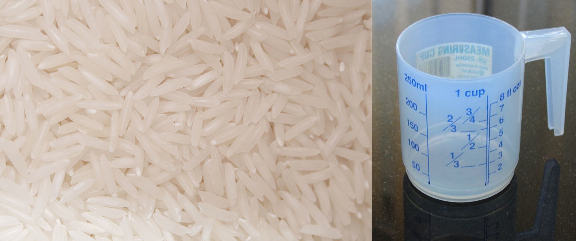How much rice and how much water?
Posted by: Gary Ernest Davis on: November 28, 2010
My wife, Linda, and I bought some Jansal Vallley Farm jasmine rice from Sid Wainer & Sons. It’s fine rice, and like most fine foods from Sid Wainer & Sons, not cheap.
The instructions on the rice packet say add cups of water to every cup of rice.
Linda found that this was too much rice, and wanted to reduce the amount.
She came to with the fraction problem: if I only want of a cup of rice, how much water do I need?
I relied: “1 cup.”
She wanted to know how I figured that.
I pointed out that a helpful way to think about the ratio of water to rice is 3 lots – whatever a “lot” is – of water to 2 lots of rice.
So, of a cup of rice is 2 lots of
of a cup of rice, so we will need 3 lots of
of a cup of water – that is, 1 cup of water.
“OK”, she said, “but say I want of a cup of rice. That might be enough for me. How much water do I need then?”
“Half a cup” I replied.
“Wait”, she said:”How did you get that?”
Because it’s 3 lots of water for every 2 lots of rice, ask yourself what of a cup is 2 lots of. Answer:
of a cup. So we need 3 lots of
of a cup of water – that is
a cup of water.
For more on thinking about fractions see here and also here.
4 Responses to "How much rice and how much water?"
After getting the answer of “1 cup” for water to be added to 2/3 cup of rice, it’s a roundabout way to repeat “it’s 3 lots of water for every 2 lots of rice …” in order to get the answer for water to be added to 1/3 cup of rice. Just divide the previous answer by 2 to get “half a cup.”
Thanks for the comment, and – yes, of course, Yet I think I did not accurately convey the overall confusion my wife had with fractions, not being sure what to do arithmetically, a confusion experienced by many adults who were taught fractions instrumentally. So I wanted to stress the fundamental relationship of 3 for every 2 which is the basis for all these calculations. I was not looking for the quickest, shortest answer, but rather trying to reinforce a basic principle. In fact I did not work out the last piece as I wrote – I mentally thought 3 for every 2, so 3 lots of 1/3 cup is 1 cup, which is 2 lots of 1/2 cup. That’s actually how I did it.
I see what you wanted to stress.


November 28, 2010 at 4:39 pm
The proportional thinking is the easy part, especially when your ratios are based on simple whole numbers. You know of a ration for rice to water. You can estimate with it and even imagine the numbers visually, aside from the symbols for ratio of proportion.
Printed cooking directions for a rice package could be wrong in the other direction also. No doubt, your formula would work just as well as a remedy.